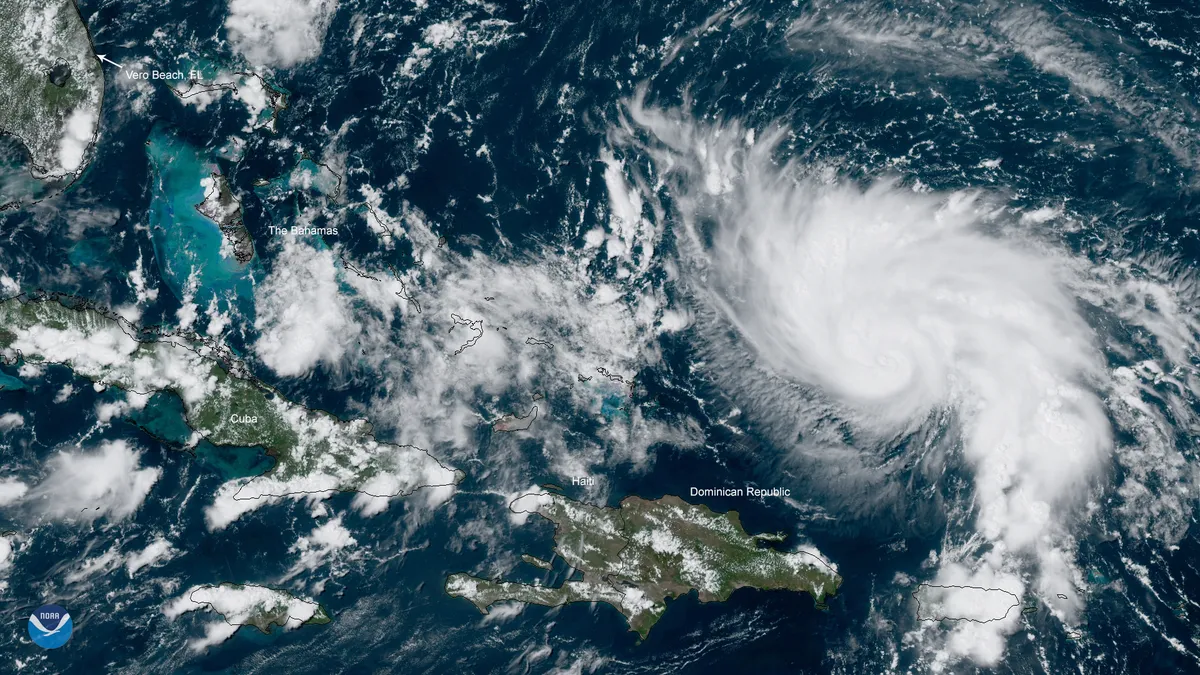UPDATE: Sept. 5, 2019: South Carolina Electric & Gas, a Dominion-owned utility, on Thursday morning reported more than 128,000 customers were without power, mostly along the state's coast. According to the National Hurricane Center, Hurricane Dorian — a Category 3 storm as of Thursday morning at 8 a.m. — was located 70 miles south-southeast of Charleston, South Carolina, with maximum sustained winds of 115 mph.
Hurricane Dorian on Wednesday morning continued its creep toward the U.S. mainland, but had slowed to a Category 2 storm — meaning electric utilities in its path could be spared the worst. But up and down the East Coast they remain on alert, having spent the last week preparing.
Tens of thousands of workers are ready for any necessary restoration work, even as utilities hope for a best-case scenario.
Dorian at 5 a.m. EDT Wednesday was located about 90 miles east of Daytona Beach, Florida, moving north-northwest at about 8 mph with sustained winds of 105 mph, according to the National Hurricane Center.
The center warned of a "life threatening storm surge and dangerous winds" for Florida, Georgia, South Carolina and North Carolina.
South Carolina Electric & Gas says it has 2,000 employees ready to go and 140 crew members from other utilities. Jacksonville-based JEA has crews arriving from Texas. Duke Energy turned a Florida cow pasture into a staging ground for thousands of workers. Santee Cooper brought in additional workers and was preparing to staff call centers 24 hours a day.
According to the Edison Electric Institute, utilities in Dorian's path all activated emergency response plans and pre-positioned workers and equipment in areas most likely to be hit. EEI said crews from at least 36 states, the District of Columbia and Canada have been offered, and "all pre-staging resource needs have been met."
"Due to the uncertain track of the storm, mutual assistance networks continue to stage and reposition crews that are ready to deploy to the areas impacted by Hurricane Dorian," the group said.
'A very unpredictable storm'
It has become a familiar routine for utilities on the Atlantic coast, and there are signs that years of practice and grid hardening are paying off.
"We learn from every storm," Florida Power & Light spokesman Bill Orlove told Utility Dive. "We are always refining how we respond to storms."
South Florida is expected to miss the brunt of Dorian, but FPL on Tuesday restored power to 70,000 customers and warned of more outages to come. Most resulted from trees and vegetation falling on equipment and power lines.
The utility had lined up a workforce of 17,000, Orlove said, with utilities from Maine to California preparing to offer mutual assistance as needed. But as the storm tracked north, the utility was considering shifting crew needs and staging locations.
"Preparations really started last week. ... As the storm slowly starts to drift north we're starting to reconsider those numbers of out of state crews," Orlove said. "Dorian has been a very unpredictable storm."
FPL's preparations, alongside efforts to underground power lines, harden poles and make substations more secure from flooding, have shown results. When Hurricane Wilma struck Florida in 2005, it took more than two weeks for the utility to return power to 95% of affected customers. After Hurricane Irma hit in 2017, it took less than a week to reach that recovery milestone.
"Those improvements have definitely paid off for our customers," Orlove said.
Once FPL's territory is in the clear and customer power has been restored, Orlove sad the utility will send its crews to help others.
Relief in Puerto Rico
So far, the worst damage from Dorian is in the Bahamas, where the storm stalled for almost two days as a Category 5. Assessments are still underway, but recovery is expected to cost billions and the death toll of 7 is likely to rise.
It is a scene familiar to Puerto Rico, which was devastated by Hurricane Maria two years ago. That storm destroyed the Puerto Rico Electric Power Authority's (PREPA) utility grid, necessitating a full rebuild. And while that effort has helped strengthen the distribution system, experts on the island say it likely isn't ready for a real test.
Agustin Carbo, senior manager of microgrids at Environmental Defense Fund, lives in Puerto Rico. He lost power for months when the island's grid was destroyed by Hurricane Maria, but says it is apparent that improvements have been made — both to the grid, and how the utility prepares for storms.
Before Maria, "there were many flaws in the planning process," Carbo told Utility Dive.
The island failed to line up mutual assistance, for instance. And its electric grid was rickety from years of little investment. "This time we were more ready," Carbo said, noting there were mainland utility crews ready to assist and a partially-hardened system as Dorian formed.
Dorian was initially forecast to strike parts of Puerto Rico, but changed course. Carbo says he is thankful because despite improvements, "we are not 100% ready."
PREPA's long-term plan for the island envisions eight largely self-sufficient electric minigrids, which Carbo said will make power restoration easier in the future. Technical hearings on the 20-year plan begin Sept. 4, he said. In the meantime, the island's grid has been improved but remains vulnerable.
"There are still challenges. The utility still has not completed the restoration of some lines. There [are] still a lot of poles that won't resist a storm," Carbo said. But, ultimately, utilities and their customers may be at the mercy of nature when storms like Dorian and Maria strike, he added.
"No one could be ready for something so outrageous and so big," he said.
CORRECTION: A previous version of this article misidentified the Jacksonville-based municipally-owned utility, JEA.






















